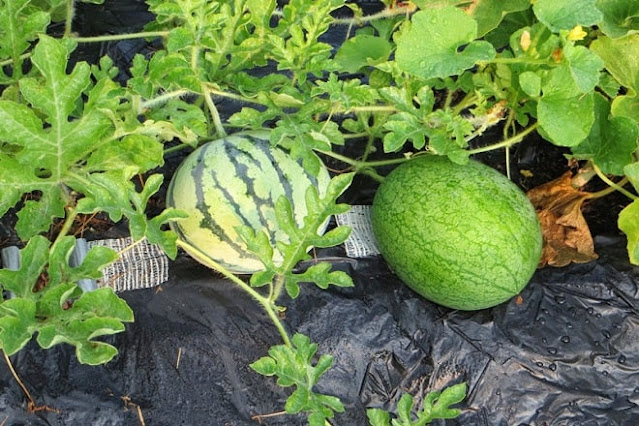
Watermelons are highly diverse in type and size. Some varieties weigh around 1 kg, while others can exceed 32 kg. In terms of color, there are both red-fleshed and yellow-fleshed watermelons. Worldwide, watermelons are classified into two types based on their shape: (1) oval-shaped watermelons (such as Jubilee, Charleston Grey, and Congo); and (2) round-shaped watermelons (like Sugar Baby and Ice Box).
Keep in mind that watermelon seeds germinate best at temperatures around 21°C. Therefore, if you live in a cold season, it’s best to postpone sowing the seeds. Instead, consider sprouting the seeds indoors for a few weeks until the weather warms up.
Watermelons thrive in sunny conditions. To ensure optimal growth and fruit production, the planting area should receive at least 6 hours of sunlight each day.
Additionally, since watermelons grow vigorously when mature, they require ample space. Typically, each watermelon plant needs an area ranging from 1.2 to 2 meters.
Watermelon prefers rich, well-draining soil. Thus, you need to till the soil, break it up, and completely remove any weeds.
To determine if the planting area has good drainage, check if water pools after a heavy rain. If it does, you may need to add more soil or create drainage channels for better water flow.
It’s advisable to add manure or organic fertilizers to improve the soil quality. If possible, check the soil’s pH level; watermelons prefer a pH range of 6 to 6.5.

You can use a hoe or a tractor (if planting a large area) to create soil mounds shaped like hills for sowing watermelon seeds. The space between the mounds should be about 1.2 to 1.8 meters.
Creating soil mounds is crucial for growing watermelon from seeds at home, as they help aerate the soil, provide sufficient oxygen for plant growth, and reduce the risk of flooding. Furthermore, during dry seasons, these mounds will help retain moisture effectively.
For each soil mound, use a tool to make about 3-4 holes, each about 2.5 cm deep.
In each hole, sow 1 to 4 seeds, depending on how many you have. Use a rake to cover the seeds lightly and press down gently to ensure the seeds are properly secured in the soil. Be careful not to compress the soil too tightly.
Typically, watermelon seeds will germinate in about 7 to 10 days, depending on the soil temperature and the depth at which you planted the seeds.
Once the seeds sprout, keep the soil around them consistently moist. At this stage, water lightly to help the watermelon roots absorb moisture.
Retain only the 2 strongest seedlings. Cut away the remaining seedlings to allow the two chosen ones to thrive.
Water the plants once a day during this time to prevent the soil from drying out.
You can use fertilizer, straw, or burlap to cover the base to prevent weeds and retain moisture.
As the watermelon fruits begin to form, ensure the leaves and fruits remain dry. You can use pieces of wood, stones, or bricks to elevate the watermelon fruits.
In hot summer weather, if the leaves wilt, water the base of the plants in the evening.
The secret to sweet watermelon is to refrain from watering them for a week before harvest.
Additionally, be sure to regularly remove weeds around the base and in the direction the watermelon vines are growing.

If grown and cared for properly, watermelons will be ready for harvest after about 4 months. Make sure the watermelons are fully ripe when harvesting.
To determine if the watermelon is ripe, lightly tap the fruit with your hand. If you hear a deep, hollow sound, it’s ready. Additionally, check the bottom of the watermelon; if it has turned from light yellow to white, it is ripe. You can also check the curly tendril near the stem; if it is dry, the fruit is ready for harvest.
Use scissors to cut the watermelon from the vine. Generally, each vine will yield about 2 to 5 fruits, depending on growth conditions.
Be mindful to repel pests such as beetles and mites that may harm the watermelon.
It is best not to sow seeds when the temperature is below 16°C. The ideal temperature for watermelon growth is around 24°C, which promotes stronger development.
Avoid using chemical fertilizers or applying too much fertilizer, as this may prevent the watermelons from fruiting.
Ý kiến bạn đọc
Những tin mới hơn
Những tin cũ hơn
 The most unique carrots in the world!
The most unique carrots in the world!
05.09.2024
 Guide to Propagating Basil Cuttings for Beginners
Guide to Propagating Basil Cuttings for Beginners
30.08.2024
 How to take care of basil plant indoors for Beginners
How to take care of basil plant indoors for Beginners
30.08.2024
 Interesting Facts About Ants
Interesting Facts About Ants
23.08.2024
 Coucal bird: Natural Enemy of Snakes
Coucal bird: Natural Enemy of Snakes
22.08.2024